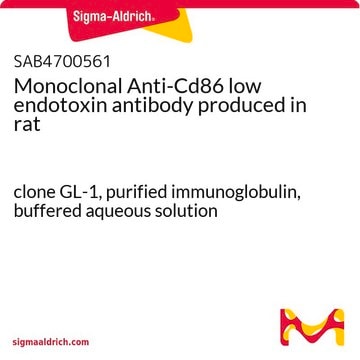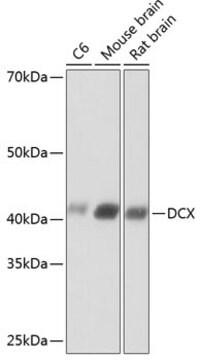おすすめの製品
由来生物
mouse
結合体
unconjugated
抗体製品の状態
purified from hybridoma cell culture
抗体製品タイプ
primary antibodies
クローン
ARG1-3, monoclonal
形状
buffered aqueous solution
分子量
antigen ~40 kDa
化学種の反応性
rat, human, mouse
濃度
~1.0 mg/mL
テクニック
western blot: 2-4 μg/mL using whole extracts of rat or mouse liver.
UniProtアクセッション番号
輸送温度
dry ice
保管温度
−20°C
ターゲットの翻訳後修飾
unmodified
遺伝子情報
human ... ARG1(383)
関連するカテゴリー
詳細
Monoclonal Anti-ARG1 (mouse IgG1 isotype) is derived from the hybridoma ARG1-3 produced by the fusion of mouse myeloma cells and splenocytes from BALB/c mice immunized with a synthetic peptide. Arginase (ARG)1 gene, codes for type I isoform of arginase. ARG1 is a cytosolic enzyme expressed predominantly in the liver as a component of the urea cycle.
免疫原
synthetic peptide corresponding to a sequence at the N-terminal region of human ARG1, conjugated to KLH. The corresponding sequence differs by 3 amino acids in mouse ARG1 and by 4 amino acids in rat ARG1.
アプリケーション
Monoclonal Anti-ARG1 antibody produced in mouse has been used in immunoblotting.
生物化学的/生理学的作用
Arginase hydrolyzes arginine to ornithine and urea. Arginases have been implicated in many disease processes, including vascular diseases, pulmonary diseases, infectious diseases, immune cell dysfunction and cancer. Inherited deficiency of ARG1 enzyme results in argininemia, an autosomal recessive disorder characterized by hyperammonemia.
物理的形状
Solution in 0.01 M phosphate buffered saline, pH 7.4, containing 15 mM sodium azide.
免責事項
Unless otherwise stated in our catalog or other company documentation accompanying the product(s), our products are intended for research use only and are not to be used for any other purpose, which includes but is not limited to, unauthorized commercial uses, in vitro diagnostic uses, ex vivo or in vivo therapeutic uses or any type of consumption or application to humans or animals.
Not finding the right product?
Try our 製品選択ツール.
保管分類コード
12 - Non Combustible Liquids
WGK
WGK 1
引火点(°F)
Not applicable
引火点(℃)
Not applicable
適用法令
試験研究用途を考慮した関連法令を主に挙げております。化学物質以外については、一部の情報のみ提供しています。 製品を安全かつ合法的に使用することは、使用者の義務です。最新情報により修正される場合があります。WEBの反映には時間を要することがあるため、適宜SDSをご参照ください。
Jan Code
SAB4200508-200UL:
SAB4200508-BULK:
SAB4200508-VAR:
試験成績書(COA)
製品のロット番号・バッチ番号を入力して、試験成績書(COA) を検索できます。ロット番号・バッチ番号は、製品ラベルに「Lot」または「Batch」に続いて記載されています。
Molecular regulation of urea cycle function by the liver glucocorticoid receptor
Okun JG, et al.
Molecular Metabolism, 4(10), 732-740 (2015)
Arginase: a critical regulator of nitric oxide synthesis and vascular function
Durante W, et al.
Clinical and Experimental Pharmacology & Physiology, 34(9), 906-911 (2007)
Xudong Sun et al.
Journal of dairy science, 107(9), 7423-7434 (2024-05-17)
Excessive concentrations of free fatty acids (FFA) are the main factors causing immune dysfunction and inflammation in dairy cows with ketosis. Polarization of macrophages (the process of macrophages freely switching from one phenotype to another) into M1 or M2 phenotypes
ライフサイエンス、有機合成、材料科学、クロマトグラフィー、分析など、あらゆる分野の研究に経験のあるメンバーがおります。.
製品に関するお問い合わせはこちら(テクニカルサービス)








